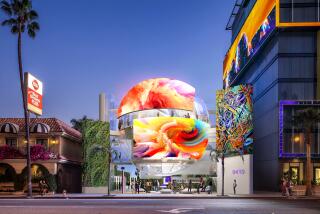Spiky Tollway Cell Phone Towers Dubbed Monstrosities
- Share via
Talk about static.
Two years after toll authorities first struck upon the idea of adding mobile telephone service to the cellular-silent Eastern Toll Road, those authorities are now giving designers an angry earful over plans to erect five futuristic antenna spires along the road, among eight antennas total.
While advocates of the 125-foot-tall, rust-tinted towers say they’re works of art and a vast improvement over the power pole type of antenna, critics say the spires are more suited to a landscape of nuclear destruction than the foothills of the Santa Ana Mountains.
“This is like a monstrosity,” said county Supervisor Todd Spitzer, a toll road board member, when he first viewed the design last week. “If I was a political cartoonist, this would be my first cartoon.”
Others were willing to accept the spires as a work of art, but not as an addition to the toll road.
“This spire belongs in a modern sculpture garden, not in the background,” said Orange Mayor Joanne Coontz, another toll road board member.
As a result, directors of the Foothill/Eastern Transportation Corridor Agency on Thursday ordered designers back to the drawing board.
In a day when cellular telephone antennas are regularly disguised as pine trees, church steeples, water towers and even cactuses, toll officials say there must be other options.
Indeed, plans presented to the transportation agency call for the construction of five spires. Two other structures would be disguised as bell towers and the eighth would look like a set of sign gantries. Directors have no problem with those other designs.
Toll directors say a lack of cellular telephone service along the corridor is keeping would-be customers from using the route, and the officials initiated talks with telephone companies about the problem shortly after the toll road was completed.
The Foothill/Eastern agency eventually hashed out an agreement whereby the telephone companies would pay for the network of antennas, Caltrans would provide the land and the Irvine Co. would provide off-road access to all but one of the structures for maintenance.
This mix of organizations is as much responsible for the controversial final design as anything else, according to Paul Gerst, a representative of the telephone companies. “Unfortunately, when you add all these concerns, you end up with a little bit of a Frankensteiny thing,” Gerst said when the plans were first unveiled.
The spires, designed by the architect who created the toll road’s Flash Gordon-style toll plazas, would be constructed of self-weathered steel, which gradually assumes a patina of dark rust. The architect, Paul Zajfen, was hired by the Irvine Co., and reasoned that since the antennas could not be concealed, they should be treated as sculptures.
The bell tower look was proposed for two sites where they would be visible to residents. Those towers, which would be roughly the same height as the spires, would be made of fiberglass, and each side would measure 16 feet across. Gerst said the bell towers would cost more than $300,000 each, compared with $180,000 for the spires.
On Thursday, a spokesman for the Irvine Co. said the project is still in the design phase and that concerns would be discussed with toll officials. All parties will meet next week on the matter, and toll road authorities will consider the design proposal again in 30 days.
In the meantime, at least one toll authority member said the conflict only increased the time that the toll road will go without cellular telephone coverage.
“This isn’t just a design issue, it’s also a safety issue,” said board member and Irvine City Council Member Mike Ward.
More to Read
Sign up for Essential California
The most important California stories and recommendations in your inbox every morning.
You may occasionally receive promotional content from the Los Angeles Times.














